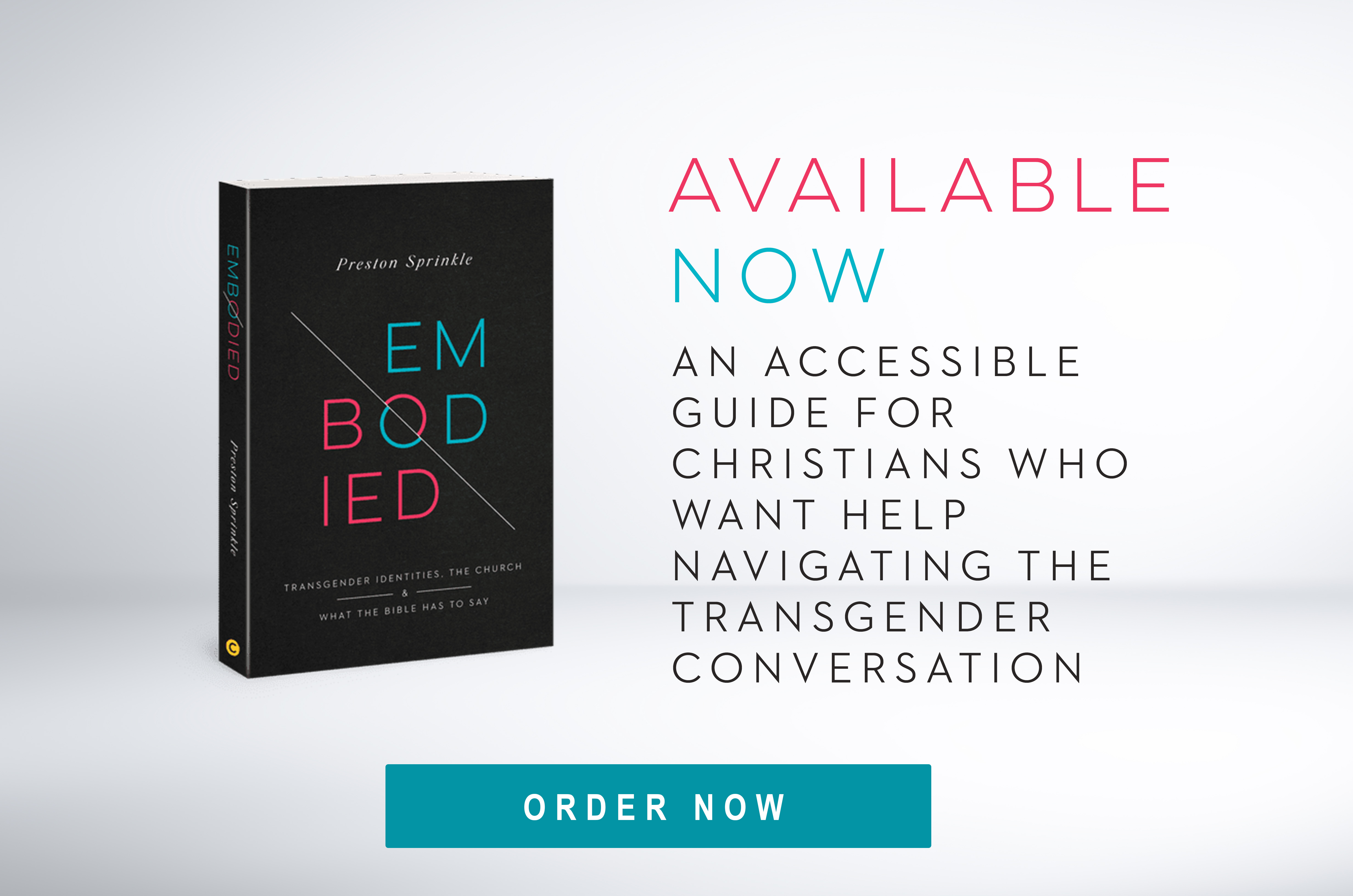
My book Embodied drops today, and I’m both nervous and excited to see how it’s received. The first question people ask me when I mention this book is, why did you write Embodied? My answer is given in the Preface to the book, which I’ve posted below in its entirety.
PREFACE
The idea for this book was sparked in 2014 on a chilly October evening in East Chicago. I was bundled up outside, smoking cigars with a gay friend named Kevin. He was encouraging me to finish my book on homosexuality.
“But I’m not gay,” I said. “We already have too many straight people talking about homosexuality.”
“Yes,” Kevin responded, “but we don’t have many straight Christians talking about us the way you do. You’re actually trying to see us as you talk about us. It feels like you’re talking with us.”
I sat back, choking on my stogie, and mulled over his kind words. But as I was letting those words sink in, he tossed out another, less-encouraging, comment.
“You know, Preston, by the time your book is published, the sexuality conversation will be surpassed by the gender conversation. Your book’s going to be dated before it hits the shelves.”
Kevin’s prophecy proved to be true. In the year between my conversation with Kevin and the publication of my book (People to Be Loved: Why Homosexuality Is Not Just an Issue) in November 2015, transgender topics gained significant traction. Caitlyn Jenner’s famed transition stirred up international attention. Hit TV shows like Transparent and Orange Is the New Black showcased transgender people, and the reality show I Am Jazz followed the daily life of Jazz Jennings, a well-known transgender child. Popular magazines like National Geographic and Time ran front-page articles about transgender people. Same-sex marriage was legalized in all fifty US states in June 2015, marking a significant victory for gay activists and making space for transgender rights as the “next civil rights frontier.”1 Trans* issues (I’ll explain the asterisk later) have quickly become a focal point in the LGBTQ conversation.
Buy Now!
Embodied: The Latest from Preston Sprinkle
In light of all these events, not long after I finished writing People to Be Loved, I turned my attention toward the trans* conversation. And once again, I found myself in over my head. When I had written People to Be Loved, my heart was turned inside out at the level of pain many gay people have endured in the pews of our churches. As I researched the book you now hold in your hands, I felt the same pain for trans* people. Millions of gay and trans* people have grown up in our churches, and many of them have left due to shame, ridicule, and dehumanization. “I’ve never met a Christian who was kind to me,” I’ve heard far too many of them say.
But I’m not trans*, I kept thinking to myself. What business do I have writing about trans* identities? I’ve held that voice close to my heart as I’ve engaged the trans* conversation. No matter how hard I try to humanize this topic—no matter how many trans* people I befriend, listen to, and learn from—I will never fully understand what it’s like to be trans*. There will always be a chasm between me and the people who are this topic.
This book is my fragile attempt to help us think more deeply and love more widely through a topic that sometimes lacks both. Over the years, though, I’ve also received piles of questions from parents, pastors, Christians, and yes, even trans* people, asking me what the Bible and science say about the topic. They’re not asking for me to write a memoir about the trans* experience. But they are asking me to help them think theologically and scientifically about human nature. What does it mean to be male and female? Are these the only two options? Is it okay for a male to act feminine, or a female to act masculine? Could someone be born in the wrong body or have the soul of another sex? What pronouns should I use for my trans* friend? Where should trans* people sleep at summer camp? Or, perhaps more urgently, my child just came out as trans*, and I don’t know what this means or what to do, but I want to love them well and honor Jesus through it all—can you help me?
This book is my fragile attempt to help us think more deeply and love more widely through a topic that sometimes lacks both. Even though my primary audience is non-trans* Christians, I hope the book can also help trans* Christians wrestling with the relation- ship between their faith identity and gender identity. I’ve tried to create a book informed by the voices, needs, concerns, and wisdom of actual trans* people. Toward that end, I asked several trans* and intersex people to review early drafts of this manuscript. Some of their comments were encouraging; others were scathing. All of them were helpful, shaping this book into its current form. I hope that the people whose experiences I’m writing about will feel honored and seen as they read, even if they (or you, the reader) don’t agree with everything I say.
Since this topic required me to study many different scholarly disciplines (neuroscience, theological anthropology, endocrinology, gender theory, and clinical psychology, among others), I had over a dozen scholars in those fields read through earlier drafts. I don’t think I’ve ever put a book through as much scrutiny as I have with this one. Whatever mistakes, offenses, or stupidities remain are, of course, my own responsibility and not those of my readers (or my beleaguered editor).
One reader stands out in particular. This person is a friend—a mentor, really—who has held my hand through this entire conversation. They’ve helped me understand difficult nuances, kicked my butt when it needed kicking, and modeled for me the love of Jesus. I owe them in more ways than they know. It is to them that I dedicate this book.

